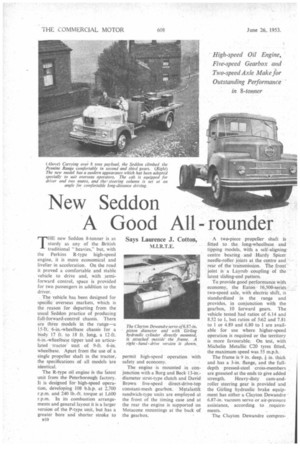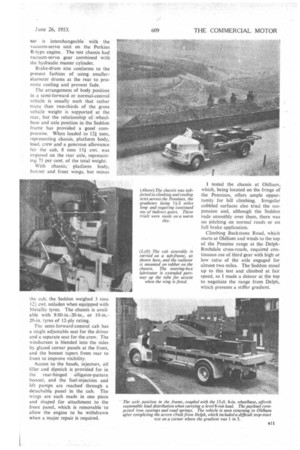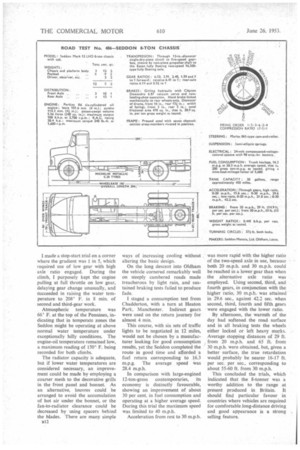New Seddon A Good All-rounder
Page 44

Page 45

Page 46

If you've noticed an error in this article please click here to report it so we can fix it.
Says Laurence J. Cotton, m.i.R.T.E. THE new Seddon 8-tonner is as sturdy as any of the British traditional "heavies," but, with the Perkins R-type high-speed engine, it is more economical and livelier in acceleration. On the road it proved a comfortable and stable vehicle to drive and, with semiforward control, space is provided for two passengers in addition to the driver.
The vehicle has been designed for specific overseas markets, which is the reason for departing from the usual Seddon practice of producing full-forward-control chassis. There are three Models in the range—a 1,5-It. 6-in.-wheelbase chassis for a body 17 ft. to 18 ft. long, a 12-ft. 6-in.-wheelbase tipper and an articulated tractor unit of 9-ft. 6-in. wheelbase. Apart from the use of a single propeller shaft in the tractor, the specifications of all models are identical.
The R-type oil engine is the latest unit from the Peterborough factory. It is designed for high-speed operalion, developing 108 b.h.p. at 2,700 r.p.m. and 240 lb.-ft. torque at 1,600 r.p.m. In its combustion arrangements and general layout it is a larger version of the P-type unit, but has a greater bore and shorter stroke to B10 permit high-speed operation with safety and economy.
The engine is mounted in conjunction with a Borg and Beck 13-in.diameter strut-type clutch and David Brown five-speed direct-drive-top constant-mesh gearbox. Metalastik sandwich-type units are employed at the front of the timing case and at the rear the engine is supported on Metacone mountings at the back of the gearbox. A two-piece propeller shaft is fitted to the long-wheelbase and tipping models, with a self-aligning centre bearing and Hardy Spicer needle-roller joints at the centre and rear of the transmission. The front joint is a Layrub coupling of the latest sliding-end pattern.
To provide good performance with economy, the Eaton 16,500-series two-speed axle, with electric shift, is standardized in the range and provides, in conjunction with the gearbox, 10 forward gears. The vehicle tested had ratios of 6.14 and 832 to 1, but ratios of 5,62 and 7.81 to 1 or 4.89 and 6.80 to 1 are available for use where higher-speed operation is required or the territory is more favourable. On test, with Michelin Metallic C20 tyres fitted, the maximum speed was 55 m.p.h.
The -frame is 9 in. deep, in. thick and has a 3-in, flange, and the fulldepth pressed-steel cross-members are gusseted at the ends to give added strength. Heavy-duty cam-androller steering gear is provided and the Girling hydraulic brake equipment has either a Clayton Dewandre 6.87-in, vacuum servo or air-pressure assistance, according to requirements.
The Clayton Dewandre compres sot is interchangeable with the vacuum-servo unit on the Perkins R-type engine. The test chassis had vacuum-servo gear combined with the hydraulic master cylinder.
Brake-drum size conforms to the present fashion of using smallerdiameter drums at the rear to promote cooling and prevent fade.
The arrangement of body position in a semi-forward or normal-control vehicle is usually such that rather more than two-thirds of the gross vehicle weight is supported at the rear, but the relationship of wheelbase and axle position in the Seddon frame has provided a good compromise. When loaded to 12f tons, representing chassis, platform body, load, crew and a generous allowance for the cab, 8 tons 151 cwt. was imposed on the rear axle, representing 73 per cent. of the total weight.
With chassis, platform body, bonnet and front wings, but minus the cab, the Seddon weighed 3 tons 121 cwt. unladen when equipped with Metallic tyres. The chassis is available with 9.00-in.-20-in., or 10-in.20-in. tyres of 12-ply rating.
The semi-forward-control cab has a single adjustable seat for the driver and a separate seat for the crew. The windscreen is blended into the sides by glazed corner panels at the front, and the bonnet tapers from rear to front to improve visibility.
Access to the heads, injectors, oil filler and dipstick is provided for in the rear-hinged alligator-pattern bonnet, and the fuel-injection and lift pumps are reached through a detachable panel in the cab. The wings are each made in one piece and shaped for attachment to the front panel, which is removable ' to allow the engine to be withdrawn when a major repair is required. I tested the chassis at Oldham, which, being located on the fringe of the Pennines, offers ample opportunity for hill climbing. Irregular cobbled surfaces also tried the suspension and, although the Seddon rode smoothly over them, there was no pitching on normal roads or on full brake application.
Climbing Buckstone Road, which starts at Oldham and winds to the top of the Pennine range at the DelphRochdale cross-roads, required continuous use of third gear with high or low ratio of the axle engaged for almost two miles. The Seddon stood up to this test and climbed at fair speed, so I made a detour at the top to negotiate the range from Delph, which presents a stiffer gradient. I made a stop-start trial on a corner where the gradient was I in 5, which required use of low gear with high axle ratio engaged. During the climb, I purposely kept the engine pulling at full throttle on low gear, delaying gear change unusually, and succeeded in raising the water temperature to 208° F. in 8 min. of second and third-gear work.
Atmospheric temperature was 66 F. at the top of the Pennines, indicating that in temperate zones the Seddon might be operating at above normal water temperature under exceptionally hilly conditions. The engine-oil temperature remained low, a maximum reading of 150° F. being recorded for both climbs.
The radiator capacity is adequate, but if lower water temperatures are considered necessary, an improvement could be made by employing a coarser mesh to the decorative grills in the front panel and bonnet. As an alternative, louvres could be arranged to avoid the accumulation of hot air under the bonnet, or the fan-to-radiator clearance could be decreased by using spacers behind the blades. There are many simple
212 ways of increasing cooling without altering the basic design.
On the long descent into Oldham the vehicle cornered remarkably well on steeply cambered roads made treacherous by light rain, and sustained braking tests failed to produce fade.
I staged a consumption test from Chadderton, with a turn at Heaton Park, Manchester. Indirect gears were used on the return journey for almost 4 min.
This course, with six sets of traffic lights to be negotiated in 12 miles, would not be chosen by a manufacturer looking for good consumption results, yet the Seddon completed the route in good time and afforded a fuel return corresponding to 16.3 m.p.g. The average speed was 28.4 m.p.h.
In comparison with large-engined 12-ton-gross contemporaries, its economy is distinctly favourable, showing an improvement of about 30 per cent. in fuel consumption and operating at a higher average speed. During this trial the maximum speed was limited to 40 m.p.h.
Acceleration from rest to 30 m.p.h. was more rapid with the higher ratio of the two-speed axle in use, because both 20 m.p.h. and 30 m.p.h. could be reached in a lower gear than when the alternative axle ratio was employed. Using second, third, and fourth gears, in conjunction with the higher ratio, 30 m.p.h. was attained in 29.6 sec., against 42.2 sec. when second, third, fourth and fifth gears were engaged with the lower ratio.
By afternoon, the warmth of the day had softened the road surface and in all braking tests the wheels either locked or left heavy marks. Average stopping distances of 29 ft. from 20 m.p.h. and 65 ft. from 30 m.p.h. were obtained, but, given a better surface, the true retardation would probably be nearer 16-17 ft. per sec. per sec., corresponding to about 55-60 ft. from 30 m.p.h.
This concluded the trials, which indicated that the 8-tonner was a worthy addition to the range at present produced in Britain. It should find particular favour in countries where vehicles are required for comfortable long-distance driving and good appearance is a strong selling feature.




































































































